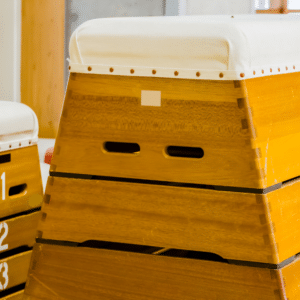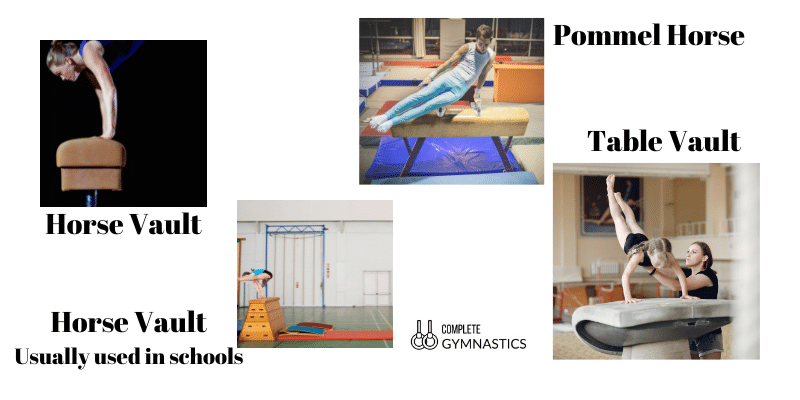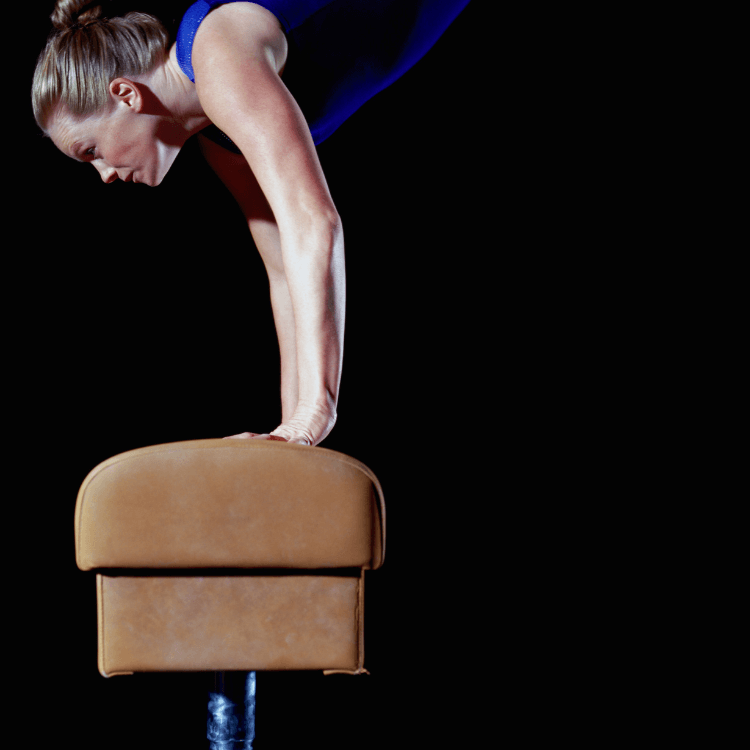In this article, I analyze an event competed by both male and female Artistic gymnasts – Vault Gymnastics (VT).
Vault is the quickest of all the events in Artistic gymnastics. From start to finish an Olympic-level gymnast can complete a vault in around 5 to 6 seconds. Blink and you’ll miss it.
There are many types of vaults in gymnastics and they all have an interesting history.
So let’s jump into the details of Vault gymnastics!

What Vault Gymnastics?
Vault gymnastics uses a block that the gymnast has to jump over by placing his or her hands on top and landing on their feet on the other side. Elite-level gymnasts will add difficulty values to a vault by increasing the number of somersaults and twists. At a beginner level, gymnasts will simply learn how to land on top of the vault block on their feet before performing a basic jump to land on the mat.
The Run-Up
The run-up is a 25-meter carpeted runway that gymnasts use to sprint and build up speed. The run-up itself isn’t sprung so gymnasts need excellent sprint technique and be ready to convert speed into a powerful jump on the springboard.
In my experience, the run-up is often neglected in training as coaches focus on the performance of the more exciting somersaults and landings at the end. However, if you can improve your run-up speed, more power will follow in the rest of the vault.
The Springboard
The springboard is a piece of wood covered in carpet and attached to a metal frame with springs. The more power you use to jump onto a springboard, the more bounce it will create for your vault. The principle is the same as a trampoline although a springboard is not as bouncy.
Depending on the type of vault being performed, gymnasts will either perform a round-off onto the springboard so they are facing backward on the springboard or they will run and jump forwards onto the board.
If you are jumping forwards for a handspring-type vault you will need to practice a long hurdle step onto the board. This is just like hopscotch where you jump from one foot to two feet. The one foot is the last step in the run-up and the two feet position is the landing on the springboard. If you can take off further away from the board it will help you generate more power.
Run too close and you will hit the springboard chest down and kill most of your bounce.
In our gym, we teach vault by pulling the springboard right out from the vault table itself. This leaves a bigger gap between the board and the vault which beginners can find scary. But by pulling the board out from a young age, gymnasts quickly get used to having to generate a bigger jump to get on and over the vault.
The Table
The modern vault is called a table and is shaped like a tongue with a large flat surface that slightly tilts down at the front. It is usually made from wood and foam with a suede cover. Newer vaults like the Gymnova ‘Montreal’ even have springs inside to help give a more dynamic push-off from the surface of the vault.
The legs are made from metal and have to be very stable to withstand the force of a gymnast making contact. The legs are often chained to the floor to help prevent them from toppling over.
At elite competitions, men will compete with the vault at 135cm whilst the women use 125cm. The height of the table vault can usually be adjusted in 5cm increments so in training younger gymnasts will be able to learn with the vault slightly lower.
Landing Mats
The final part of the vault is the landing. Gymnasts are expected to land on their feet within the funnel-shaped landing zone.
The landing mat for the vault is 6 meters in length and 2 meters wide.
The history of gymnastics vaulting
Vaulting has been part of Olympic gymnastics since the first modern games in 1896 and early forms of the apparatus were developed by one of the founding fathers of the sport, Friedrich Ludwig Jahn (1778-1852). Jahn used early forms of gymnastics movements to train the military prospects of his homeland – Germany.
The rules and scoring of the vault at the 1896 Olympic Games were very different from modern vaulting. Gymnasts were given a maximum of two minutes to perform as many vaults as they could to impress the judges.

What is the horse called in gymnastics?
The horse used in the gymnastics vault is simply called the “vaulting horse.” It is important to note that the term “horse” is often used interchangeably with the word “apparatus” in gymnastics, and in this context, both terms refer to the equipment used for the vaulting event.
In the 90s and noughties, the vaulting horse was replaced with the vaulting table and as a result, the term horse is used much less frequently in gymnastics nowadays.
What is the history of the vaulting horse?
Gymnastics, as a sport, has its roots in ancient civilizations. The ancient Greeks practiced a form of gymnastics that included exercises on the vaulting horse as part of their military training. This early form of the vaulting horse was likely a simple wooden contraption, used to train soldiers in jumping over obstacles during warfare.
Initially, the horse was designed as a simple rectangular wooden box with a leather cover, and it was used primarily for training and conditioning purposes. As gymnastics evolved, so did the horse. It became more refined, with padded sides and a non-slip surface, to provide a better grip and reduce the risk of injury.
19th Century Developments
As gymnastics evolved into a modern sport during the late 19th century, the vaulting horse became a standard apparatus in men’s artistic gymnastics. Early versions of the modern vaulting horse had a cylindrical body with a flat top and two pommels (handles) on top. Male gymnasts would perform exercises that involved swinging their legs over the horse while holding onto the pommels. This developed into the Pommel Horse which today is still an apparatus competed in Men’s Artistic gymnastics.
Whilst the Pommel Horse developed into its own apparatus, the Vault also became a standalone event.
The Vault used the same rectangular wooden apparatus but without the handles. This allowed gymnasts to jump and flip over the equipment by placing their hands on top without colliding with the handles.
Women were also using the Vaulting Horse from early in the 20th century making the Vault a core apparatus for both genders as opposed to the Pommel which has traditionally been a male-only event.

Pommel Horse v Vault
The Vault Horse is often confused with the Pommel Horse, as both apparatuses look very similar in design. However, there are distinct differences between the two. The pommel horse is smaller and has two handles whereas the vault horse has no handles. The pommel horse is primarily used for circular and scissor-like routines, with gymnasts shifting their weight from one handle to the other.
The pommel horse requires precise movements and a number of skills are linked together to create a routine.
Meanwhile, the vaulting horse is used for more powerful and explosive movements like Handspring, Tsukahara and Yurchenko vaults.
Why did the vault horse change in gymnastics?
Over the years, the design of the vaulting horse has undergone significant changes to improve the safety and performance of the gymnasts. In the past, the horse had a rigid wooden construction, which made it difficult for gymnasts to generate the necessary power for their vaults. Additionally, the lack of padding made the apparatus quite dangerous, increasing the risk of injury during training and competition.
There were several high-profile accidents involving the old-style vaulting horse in the 80s and 90s and authorities started to look into ways to improve safety on the vault.
The modern vaulting table is designed with a padded top and non-slip sides, which provide gymnasts with a safe and secure surface to launch their vaults. The area for gymnasts to place their hands is much larger and as a result, their hands are less likely to slip off.
Today, the vaulting table is the standard apparatus for both men’s and women’s gymnastics. The evolution of the vaulting horse to the vaulting table reflects the broader trend in gymnastics towards increasing technical difficulty, athleticism, and innovation.

How is vault scored in gymnastics?
Vault is a difficult apparatus for judges to score as it happens so quickly. A difficulty score and execution score are added together for the total score on each vault. At major competitions, there will be three types of judges and gymnasts will perform two different vaults.
Before the gymnast starts their vault they await a signal from the Head Judge. The gymnast then salutes and begins their run up to the vault.
- Difficulty Judge. Each vault will have a difficulty score attached to it and this judge has to check which vault was performed and how much it is worth.
- Execution Judges. Analyze the performance and deduct points for any errors.
- Head Judge. Oversees the other judges
Execution Judges mark their score out of 10 and look at each part of the vault as follows:
- 1st flight phase (take off from the springboard onto the vault).
- 2nd flight phase (after the hands push off from the vault) Judges want to see a dynamic push upwards.
- Body position at the moment the hands touch the vault table.
- Whether the gymnast stays in a straight line.
- Technical execution during the entire vault.
- The landing.
Execution Judges will deduct small errors 0.10, medium errors 0.30 and 0.50 for large errors.
The FIG (Federation of International Gymnastics) is responsible for governing the rules of gymnastics and produces a lengthy Code of Points which is essentially the rule book for vault and all other gymnastics apparatus.
Types of Vault in Gymnastics
The types of vaults in gymnastics can be split into different families (categories). The vault is defined by the type of movement performed onto the vault.
Handspring Vaults
Handspring vaults take off forward and pass through the handstand shape as the hands contact the vault table. To increase the difficulty of a handspring vault a somersault and twists can be added after the handstand phase.
Tsukahara Vaults
Tsukahara vaults are named after Mitsuo Tsukahara. It involves a half turn onto the vault table so the gymnast is facing backward when the hands touch the vault. This effectively leads the gymnast into a back somersault after they push off from the vault.
Yurchenko Vaults
Yurchenko vaults are distinctly different as the gymnast performs a round-off onto the springboard then a back handspring onto the vault. A U-shaped block must be placed around the springboard in case the gymnast misplaces their feet in the round-off! First performed by Soviet gymnast Natalia Yurchenko in 1982, the vault has also spawned many variations in subsequent years.
How do you learn to vault?
As with all gymnastics skills, you have to break things down into smaller chunks and progressions. Younger gymnasts will first learn how to run and jump onto the springboard without a vault table.
Beginner vaults include:
- Squat on – land in a squat position on top of the vault
- Squat through – the same approach as a squat on but continue through to the landing mat without stopping on top
- Handspring flatback – have landing mats stacked up level with the height of the table and perform a handspring to land on the back (in a hollow dish)
It is very common to stack up block mats on the landing zone so that gymnasts can start to learn new vaults without worrying too much about the landing. Professional gym facilities also use foam pits to land in for the same reason.
What are the hardest-ever vaults?
Generally speaking, male gymnasts are able to perform the hardest vaults at elite-level competitions. A gymnast who performs a new skill at a competition for the first time will have it named after them. New vaults have often been performed for the first time at international competitions. The world of gymnastics is always evolving and there are certain to be new difficulties added to vault in the future.
Hardest men’s vaults
The hardest men’s vaults that have been performed include:
The Yang Hak Seon is a front handspring (layout) triple twist named after the South Korean gymnast who first performed this vault at the 2011 World Championships. Yang Hak Seon has the nickname ‘The God of Vault’ and has won several world titles.
The Ri Se Gwang is a Tsukahara-type vault (round off onto the vault) followed by a double tuck back salto. The first salto also has a full twist. Named after the North Korean gymnast who is considered a vault specialist.
Hardest women’s vaults
The hardest women’s vaults performed by female gymnasts include:
Produnova. The Produnova is a handspring vault with a double tuck front somersault. Named after Yelena Produnova who first competed this vault in 1999 it has been nicknamed ‘the vault of death’ and is very rarely competed by gymnasts.
Biles. The Biles is named after American gymnast Simone Biles which is probably no surprise! The Biles is a Yurchenko-type vault as it uses the round-off on the springboard into a back handspring on the vault table. However, Biles adds a half turn before her hands touch the vault and then does a double-twisting front salto. We first saw Simone Biles perform this vault at the 2018 World Championships in Doha.
The Yurchenko Double Pike involves a round-off back handspring onto the vault followed by a double backward somersault in the piked position.
Who are the best gymnasts at vault?
Anyone who has a gymnastics vault named after them must be good!
- Simona Amanar (Romania)
- Simone Biles (USA)
- Cheng Fei (China)
- Oksana Chusovitina (USSR, Germany, Uzbekistan)
- Marian Dragulescu (Romania)
- Shigero Kasamatsu (Japan)
- Svetlana Khorkina (Russia)
- Ioannis Melissanidis (Greece)
- Aliya Mustafina (Russia)
- Jaycie Phelps (USA)
- Yelena Produnova (Russia)
- Ri Se Gwang (North Korea)
- Kyle Shewfelt (Canada)
- Mitsuo Tsukahara (Japan)
- Yang Hak-Seon (South Korea)
- Natalia Yurchenko (USSR)
- Elena Zamolodchikova (Russia)
Sources:
Men’s Artistic Code of Points (FIG)
Women’s Artistic Code of Points (FIG)
- How to Do a Back Handspring: Complete Step-by-Step GuideLearning how to do a back handspring is an exciting milestone for any gymnast. It builds confidence, agility, and forms the foundation for advanced tumbling… Read more: How to Do a Back Handspring: Complete Step-by-Step Guide
- How To Get Over a Mental Block In Gymnastics: A Complete GuideGymnastics is a sport that requires not only physical strength and skill but also mental strength. When a gymnast feels like they cannot attempt a… Read more: How To Get Over a Mental Block In Gymnastics: A Complete Guide
- The Best Leotard for Girls in 2025: What to Look ForFinding an ideal leotard for girls isn’t just about picking a dazzling design that sparkles (although it does help!). The leotard has to fit perfectly,… Read more: The Best Leotard for Girls in 2025: What to Look For
- The Best Gymnastics Shorts (Our Top Picks)The best gymnastics shorts are designed to be worn over the top of a leotard providing additional coverage around the upper legs, whilst allowing gymnasts… Read more: The Best Gymnastics Shorts (Our Top Picks)
- Decathlon Leotards – Are They Any Good?If you’re in the market for a new leotard, you may be wondering if Decathlon leotards are any good considering the low cost of their… Read more: Decathlon Leotards – Are They Any Good?
- A Complete Guide to Gymnastics Hand RipsAre you tired of dealing with painful gymnastics rips on your hands from training? Look no further – this article offers a comprehensive approach to… Read more: A Complete Guide to Gymnastics Hand Rips






